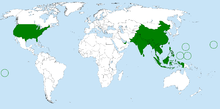| Bactrocera dorsalis | |
|---|---|

| |
| Scientific classification | |
| Domain: | Eukaryota |
| Kingdom: | Animalia |
| Phylum: | Arthropoda |
| Class: | Insecta |
| Order: | Diptera |
| Family: | Tephritidae |
| Genus: | Bactrocera |
| Species: | B. dorsalis
|
| Binomial name | |
| Bactrocera dorsalis (Hendel, 1912)
| |

| |
| Bactrocera dorsalis range (by country) | |
| Synonyms | |
|
Dacus dorsalis | |
Bactrocera dorsalis, previously known as Dacus dorsalis and commonly referred to as the oriental fruit fly, is a species of tephritid fruit fly that is endemic to Southeast Asia. It is one of the major pest species in the genus Bactrocera with a broad host range of cultivated and wild fruits.[1] Male B. dorsalis respond strongly to methyl eugenol, which is used to monitor and estimate populations, as well as to annihilate males as a form of pest control.[2][3][4] They are also important pollinators and visitors of wild orchids, Bulbophyllum cheiri and Bulbophyllum vinaceum in Southeast Asia, which lure the flies using methyl eugenol.[5][6]
The fly is similar to the closely related species B. carambolae and B. occipitalis. The species name B. dorsalis is identical to other synonyms B. papayae, B. invadens and B. philippinensis.[7] [8] [9]
- ^ Drew RA, Raghu S (December 2002). "The fruit fly fauna (Diptera: Tephritidae: Dacinae) of the rainforest habitat of the Western Ghats, India" (PDF). Raffles Bulletin of Zoology. 50 (2): 327–52.
- ^ Tan KH, Serit M (April 1994). "Adult population dynamics of Bactrocera dorsalis (Diptera: Tephritidae) in relation to host phenology and weather in two villages of Penang Island, Malaysia". Environmental Entomology. 23 (2): 267–75. doi:10.1093/ee/23.2.267.
- ^ Hee AK, Tan KH (December 2005). "Bioactive fractions containing methyl eugenol-derived sex pheromonal components in haemolymph of the male fruit fly Bactrocera dorsalis (Diptera: Tephritidae)". Bulletin of Entomological Research. 95 (6): 615–20. doi:10.1079/BER2005392. PMID 16336709. S2CID 7704353.
- ^ Wong, Tim T. Y.; McInnis, Don O.; Nishimoto, Jon I. (1989-04-01). "Relationship of sexual maturation rate to response of oriental fruit fly strains (Diptera: Tephritidae) to methyl eugenol". Journal of Chemical Ecology. 15 (4): 1399–1405. doi:10.1007/BF01014839. ISSN 1573-1561. PMID 24272021. S2CID 35091525.
- ^ Tan KH, Nishida R, Toong YC (2002). "Bulbophyllum cheiri's floral synomone lures fruit flies to perform pollination". J. Chem. Ecol. 28 (6): 1161–72. doi:10.1023/A:1016277500007. PMID 12184394. S2CID 36621985.
- ^ Tan KH, Tan LT, Nishida R (November 2006). "Floral phenylpropanoid cocktail and architecture of Bulbophyllum vinaceum orchid in attracting fruit flies for pollination". Journal of Chemical Ecology. 32 (11): 2429–41. doi:10.1007/s10886-006-9154-4. PMID 17082990. S2CID 15812115.
- ^ Schutze MK, Aketarawong N, Amornsak W, Armstrong KF, Augustinos AA, Barr N, et al. (April 2015). "Synonymization of key pest species within the B actrocera dorsalis species complex (D iptera: T ephritidae): taxonomic changes based on a review of 20 years of integrative morphological, molecular, cytogenetic, behavioural and chemoecological data" (PDF). Systematic Entomology. 40 (2): 456–71. doi:10.1111/syen.12113. S2CID 55454748.
- ^ Tan, K.H., I. Tokushima, H. Ono and R. Nishida (2011) Comparison of phenylpropanoid volatiles in male rectal pheromone gland after methyl eugenol consumption, and molecular phylogenetic relationship of four global pest fruit fly species - Bactrocera invadens, B. dorsalis, B. correcta and B. zonata. Chemoecology, 21: 25-33.
- ^ Tan, K.H., Wee, S.L., Ono, H. and Nishida, R. (2013) Comparison of methyl eugenol metabolites, mitochondrial COI, and rDNA sequences of Bactrocera philippinensis (Diptera: Tephritidae) with those of three other major pest species within the dorsalis complex. Applied Entomology and Zoology 48 (3), 275-282.